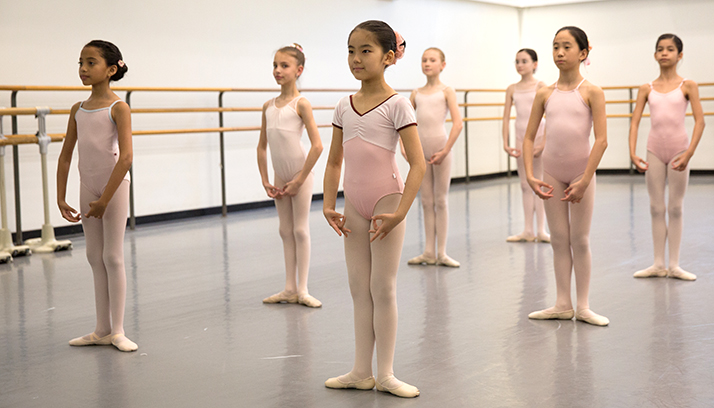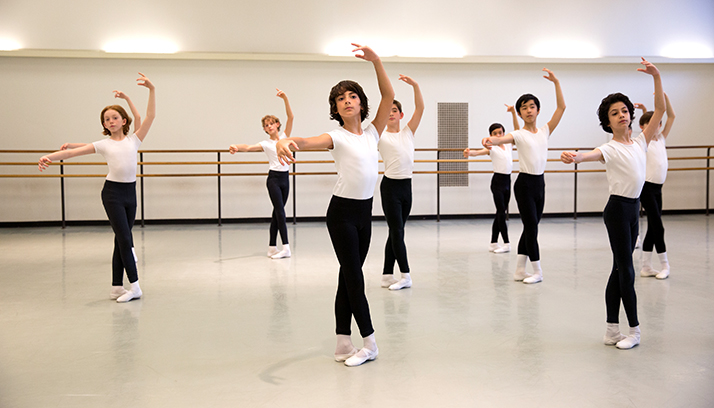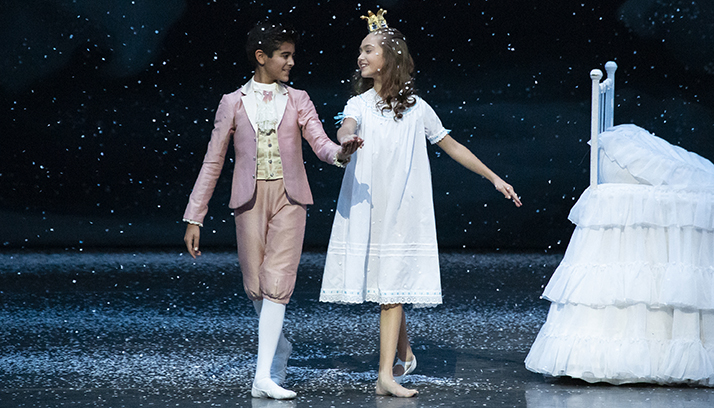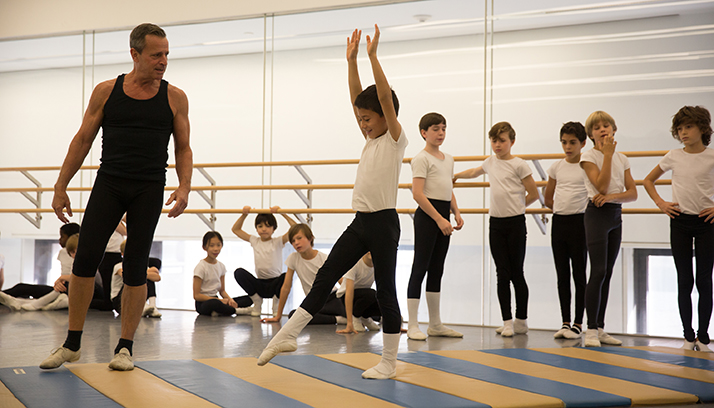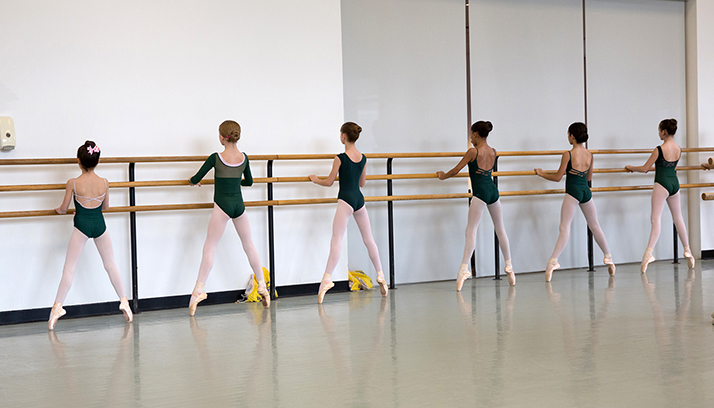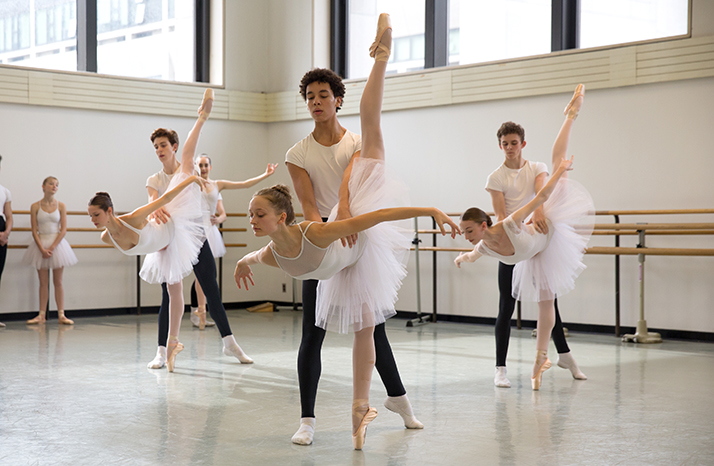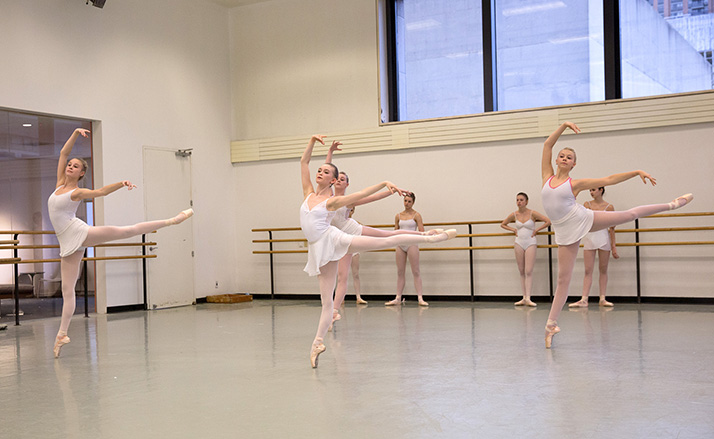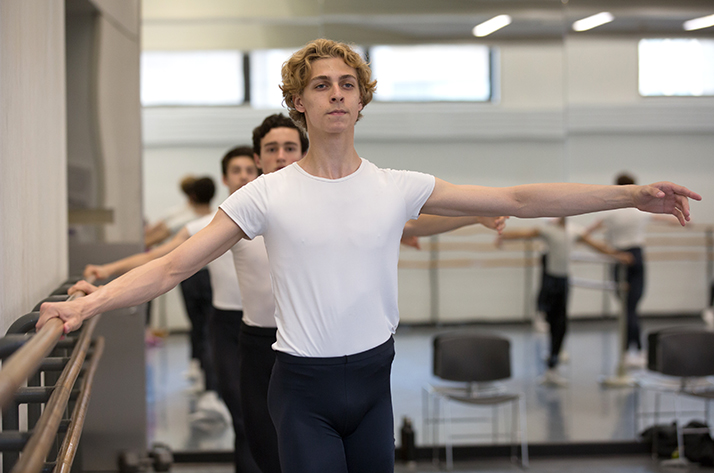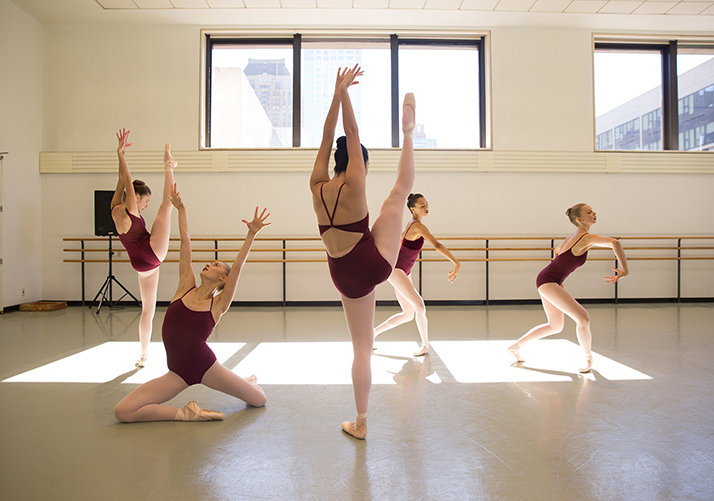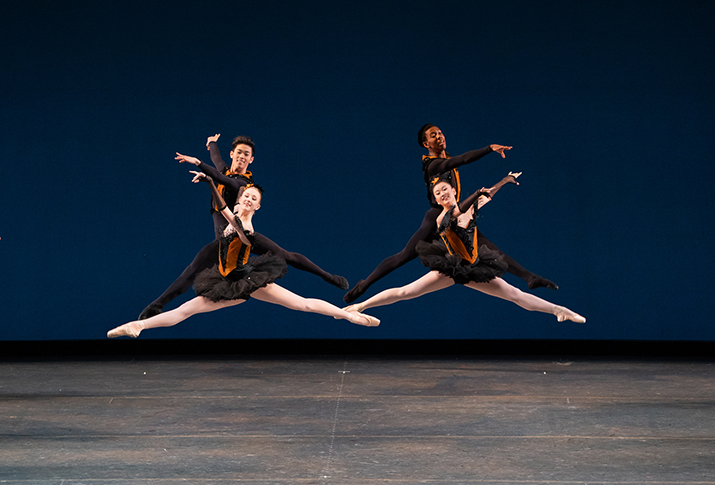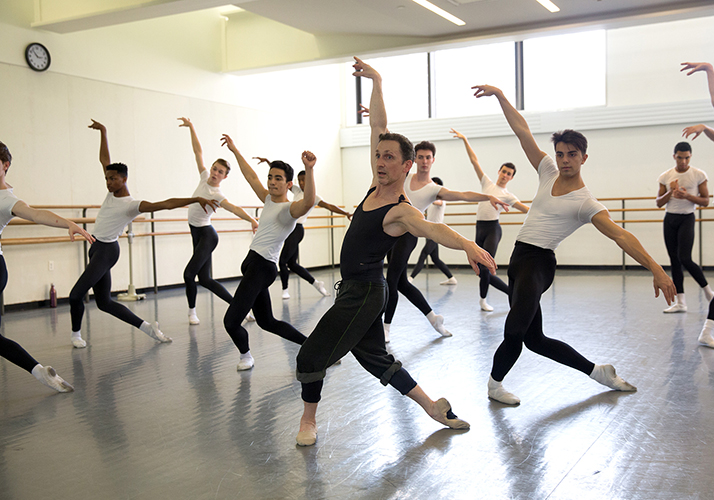Artistic Programs
The School of American Ballet’s training is designed for dedicated, focused students who show age-appropriate aptitude and physical development suited to the demands of classical training at all levels of development. The curriculum spans beginning instruction for 6 year olds through highly advanced courses designed to launch the nation’s most talented students into professional careers. The progressively exacting syllabus provides a complete education in classical ballet as refined by George Balanchine and legendary faculty members who have handed down elements of the Russian, English and Danish classical ballet traditions to today’s teachers. Dedicated boys-only classes are offered at Children’s, Intermediate, and Advanced Divisions and accomplished musicians provide live piano accompaniment for all classes school-wide. As students progress, the ballet curriculum is supplemented with complementary offerings and performing opportunities that help to develop a complete dancer. After successfully auditioning and enrolling, students are evaluated on a continual basis and advancement is contingent upon the ongoing demonstration of progress and professional potential.
Preparatory Division
The Preparatory Division enrolls 6 and 7 year olds who are either new to ballet or who have taken creative movement and beginning ballet classes elsewhere. The Preparatory curriculum focuses on the basic elements of ballet technique and nurtures the discipline that focused ballet training demands. In two 1-hour ballet technique classes per week, students experience the fundamental components of a ballet class—barre and center work—and learn characteristics essential to success in ballet, including respect for teachers and classmates, self control, persistence and patience. Progression from the Preparatory Division to the Children’s Division is not automatic. Students must demonstrate a sufficient level of interest, focus, and technical progress to advance to the next level of training. While re-enrollment decisions operate on an annual cycle, on rare occasions Preparatory Division students may be asked to depart the School mid-year should they fail to demonstrate sufficient maturity or behave in a way that is counterproductive to the overall progress of the class. Parents of Preparatory Division students are invited to observe their children in class at the end of the Winter Term.
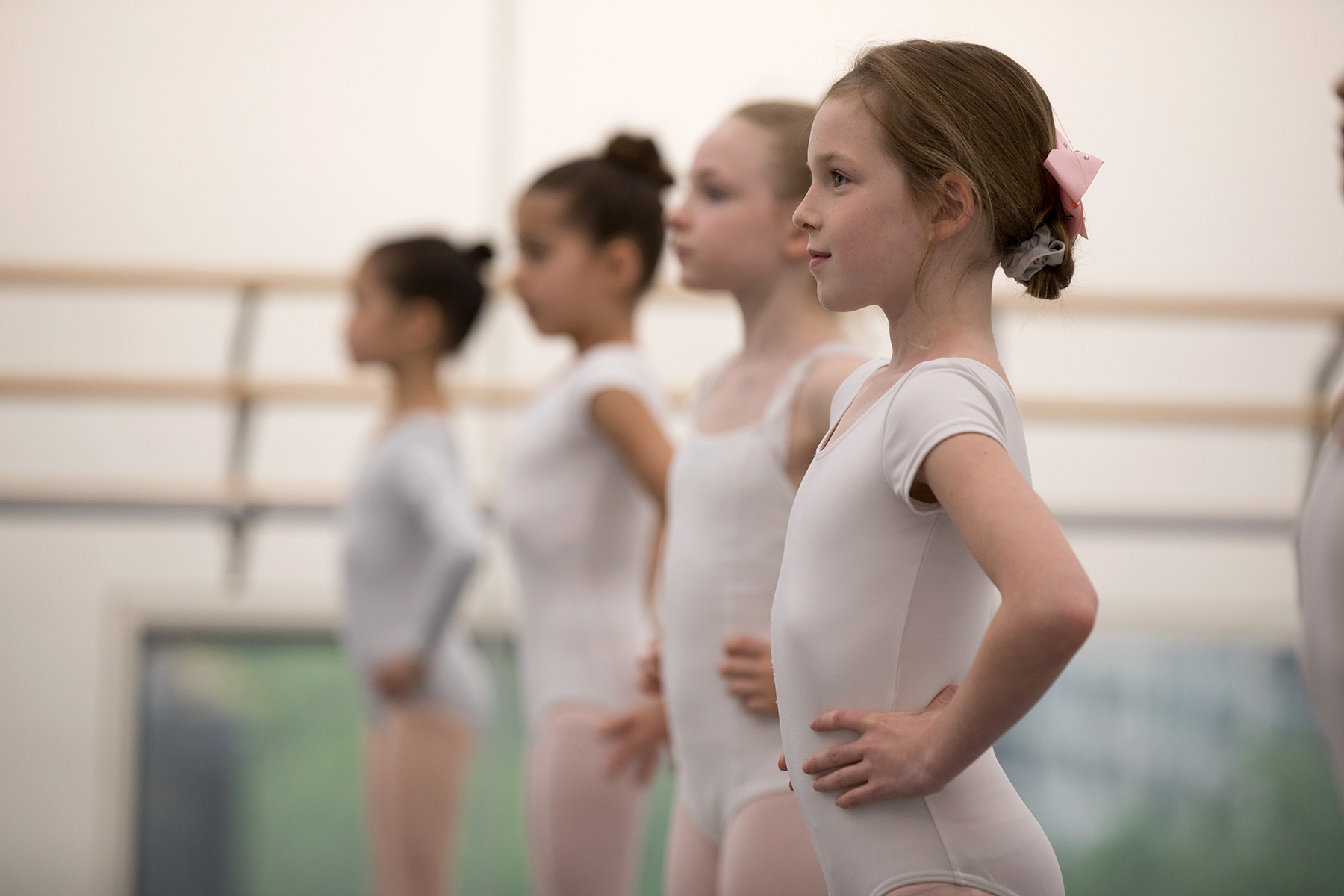
Children's Division
The Children’s Division enrolls students from the greater New York metropolitan area ranging in age from 8 to 13. Boarding is not available for students in this division. The intensity, frequency, and complexity of training progresses as children advance through five levels for girls and four levels for boys. Class level placement is based on a combination of age and advancement, and instruction is highly specific, with individualized corrections ensuring that all students receive the feedback necessary to master the material presented. Parents of Children’s Division students are invited to observe their children in class during special visit days in January, April and June.
Ballet Technique
The technique taught at SAB is based on the Russian classical tradition as taught and refined by George Balanchine. At the outset of training, the basic syllabus is the same for girls’ and boys’ levels. All Children’s Division classes focus on the basic elements of ballet technique.
Pointe
Pointe work is undertaken when the student has learned basic technique and when her legs and feet are sufficiently developed. Students begin introductory pointe work in Girls IV.
Gymnastics
The system of physical exercise involved in acrobatic gymnastics is in sharp contrast to the musically determined dynamic of classical ballet. However, gymnastics is a powerful aid in the development of muscular strength and control. An optional Saturday morning gymnastics class is offered to boys enrolled in levels Boys II, Boys III and Boys IV.
Adagio
Students enrolled in Boys IV take a weekly introductory adagio classes to learn fundamental partnering skills and etiquette. These classes are carefully tailored to the physical capabilities of boys in early adolescence. Girls from the Intermediate Division B2 class serve as partners.
Performance Opportunities
As the official academy of New York City Ballet, SAB provides all children who appear with the Company at Lincoln Center in ballets featuring roles for children. Typically, children enrolled in Girls II-V and Boys II-IV are eligible for consideration. The selection of students for NYCB productions is made solely by the Company’s children’s ballet masters. The opportunity to perform with New York City Ballet provides rich insight into the joys and demands of a life on the stage, but selection for roles is not an indication of future professional potential. Casting decisions are made largely based on height and other factors that are not directly connected to progress in SAB’s studios. Children’s Division students may also be cast in SAB’s spring Workshop Performances at the Peter Jay Sharp Theater, although Workshop more commonly features students from the Advanced Division.
New York City Ballet productions in which SAB’s children perform include:
George Balanchine’s The Nutcracker™
A Midsummer Night’s Dream (Mendelssohn/Balanchine)
Harlequinade (Drigo/Balanchine)
Firebird (Stravinsky/Balanchine)
Circus Polka (Stravinsky/Robbins)
Coppélia (Delibes/Balanchine/Danilova)
Mother Goose Suite (Ravel/Robbins)
Union Jack (traditional songs, Kay/Balanchine)
Mozartiana (Tschaikovsky/Balanchine)
The Sleeping Beauty (Tschaikovsky/Martins after Petipa)
Swan Lake (Tschaikovsky/Martins after Ivanov, Petipa and Balanchine)
Scènes de Ballet (Stravinsky/Wheeldon)
Carnival of the Animals (Saint-Saëns/Wheeldon)
Evaluation and Progression
Mid-year evaluation conferences are conducted with parents of all Children’s Division students, and in late-spring, faculty make determinations concerning enrollment invitations for the next school year. Girls enrolled in the Children’s Division (Girls I-V) typically spend one year in each Girls level, although it is not uncommon for a student to be asked to repeat a class level for a variety of reasons. Boys enrolled in the Children’s Division typically spend two years in each Boys level. It is also possible that students will not be invited to re-enroll for the following year if the faculty feel they do not show sufficient aptitude or strength for continuing success with our progressively challenging syllabus. While enrollment decisions operate on an annual cycle, on rare occasions Children’s Division students may be asked to depart the School mid-year should they fail to demonstrate sufficient maturity or behave in a way that is counterproductive to the overall progress of the class.
Intermediate & Advanced
Training in the Intermediate and Advanced Divisions is focused entirely on pre-professional students who are committed to training 6-days per week and working towards the possibility of a professional ballet career. Students hail from both the local New York metropolitan area as well as from around the United States and abroad. Over 60 non-local students aged 14 -18 reside in our onsite residence hall while training during the Winter Term. The Intermediate Division consists of two class levels for girls (B1 and B2) and Intermediate Men. The Advanced Division consists of three levels for girls (C1, C2 and D) and Advanced Men. Students who are at a later stage of training at the time of admission to SAB will be placed in the class level most suited to their skill and advancement. Classes in these levels focus on refining technique and instilling the necessary versatility, artistry and discipline to achieve a career in classical ballet.
Technique
Technique classes in the Intermediate and Advanced Divisions increasingly emphasize the hallmarks of the classical aesthetic shaped by George Balanchine’s teaching and choreography. Students strive to increase control, precision, speed and musicality, and further develop the ability to learn combinations quickly and apply corrections as soon as they are given.
The contrast between male and female dancing is increasingly emphasized at the Intermediate and Advanced levels. Boys classes focus on the physical strength, power, and brilliance of male dancing with particular emphasis on elevation, pirouettes and beats.
Pointe
George Balanchine’s goal for dancers to move quickly and effortlessly en pointe necessitates a level and intensity of pointe training that sets SAB apart from other schools. Intermediate girls B1 and B2 take a progressively increased number of classes on pointe, working towards the goal of training fully on pointe once they reach the Advanced Division. Girls in the Advanced Division wear pointe shoes for all technique classes as well as for pointe, classical variations and partnering classes.
Variations
The studio becomes a stage in Variations class as students learn excerpts from classical and contemporary ballets, in separate classes for men and women. Included are variations from George Balanchine’s* ballets such as Serenade, Who Cares?, Raymonda Variations, Square Dance, Agon, Swan Lake, Apollo, and Stars and Stripes. They are taught by faculty members who draw upon their extensive performance experience to present students with the keys for transforming technique into art. Classic Petipa and Bournonville variations are also taught by SAB’s core faculty and by guest instructors who have notable professional performing experiences with those choreographers’ works.
Adagio
The art of performing together in pas de deux is taught to all Intermediate and Advanced Division students, with Advanced students acquiring the skill to take on notable pas de deux from the classical canon as part of their class training. Intermediate and Advanced girls take one partnering class per week, while their male counterparts take two partnering classes per week.
Music
Each student’s progress toward professionalism is inextricably related to his or her understanding of music. The School’s music curriculum (for levels B1, B2, C1 and Intermediate Men) develops and strengthens not only students’ musical skills but begins effectively to cultivate musical sensitivity and understanding. In the first year, students learn basic rhythm training and the harmonic system. In the second and third years, students begin developing musical sensitivity by listening, learning musical terminology and history; and they become familiar with composers, especially those associated with dance.
Character
This course acquaints students with the polonaise, mazurka, and other formal and folk dances of the past that appear not only in the classical repertory such as Coppélia, The Nutcracker, and The Sleeping Beauty, but also in contemporary works. Character class is taught to B2 and Intermediate Men.
Strength Training and Conditioning
The need for Intermediate and Advanced male students to strengthen the musculature of their upper bodies, thereby enhancing partnering skills, is addressed in the School’s year-round program of body conditioning and strengthening taught by a trainer who also a licensed physical therapist.
A weekly conditioning class for the Advanced Girls D class ensures that students are strengthening and developing muscles to aid in the prevention of injury and prepare the body for the rigors of classical ballet training and performing.
Additionally, SAB’s Wellness Program includes Pilates, Physical Therapy and Nutrition resources, aimed at further supporting students’ physical development and well-being.
Contemporary and Choreography Composition
New for Winter Term 2023-2024, contemporary and choreography composition classes have been added for students in B2, Intermediate Men, and above. The weekly class allows students to explore improvisation and the choreographic process with their peers in a creative and supportive environment.
Choreography Projects
In 1997, the School’s Student Choreography Workshop was initiated to provide students enrolled in the Intermediate and Advanced Divisions with the opportunity to explore the art of choreography by working with fellow students. Each fall, students are invited to apply as choreographers. Selected students consult with SAB’s music instructor on their music selections and select up to four dancers from SAB’s Advanced Division on whom they will choreograph a short ballet. Student choreographers are allotted studio rehearsal time over a two week period, culminating in a series of performances in a workshop setting for faculty, staff, fellow students, parents and friends of the School.
Recognizing that relatively few women enter the field of choreography, SAB launched the Female Choreography Project in 2014 through support from the Virginia B. Toulmin Foundation. The project empowers advanced female dancers at SAB to explore choreography and consider it as a career path as they create works, experience performances by professional female choreographers, and interact with and learn from these women.
Performance Opportunities
Although the emphasis at SAB is on training rather than performance, students have unique opportunities for stage experience through SAB’s programs and through its affiliation with New York City Ballet. Performances for Advanced Division students include the Spring Workshop, SAB’s annual fully staged production; the SAB Student Choreography Workshop; the New York Choreographic Institute, NYCB’s lecture-demonstration program and SAB’s Beauty of Ballet community outreach performances in Brooklyn, Queens, Harlem and Bronx. Additional performing opportunities with NYCB are offered periodically.
The Workshop Performances in particular offer an exceptional opportunity for advanced students to preview the demands of professional life, as they learn complete masterworks from the classical and contemporary repertoires over two months in SAB’s studios, followed by rehearsals and public performances with a live professional orchestra at Lincoln Center’s Peter Jay Sharp Theater in early June.
Teacher Training
Students in C2, D, and Advanced Men may apply for positions as Teaching Assistants for Children’s Division classes. Those selected are assigned to specific class levels for the full Winter Term and work in support of faculty members as they teach the Children’s Division syllabus. Hands-on exposure to the teaching of ballet fundamentals provides valuable insights to those interested in a future career in teaching and enhances the Advanced student’s own training success through a deeper understanding of the building blocks of proper technique. Teaching Assistants earn minimum wage as set according to the laws of the State of New York and work in late afternoons and early evenings after Advanced classes have ended for the day.
Evaluation and Progression
Advancement in the Intermediate and Advanced Divisions is highly individualized to ensure that students are training at the appropriate level for facilitating maximum learning and growth. Promotions from the Intermediate Division to the the Advanced Division are made with great care, as Advanced students must transition to specialized academic offerings that are compatible with this division’s daytime training schedule. Intermediate students who demonstrate insufficiently strong professional potential are not invited to continue into the Advanced Division. Mid-year conferences are scheduled with parents of Intermediate students to discuss potential impediments to progression, and final re-enrollment decisions are made in the spring. It is common for students in the Intermediate and Advanced Divisions to train in each level for more than one year. Training is considered complete when a student’s skill has reached a professional level, usually at age 17 or 18.

